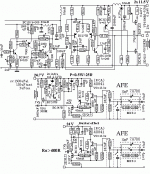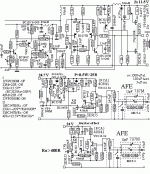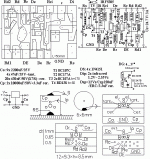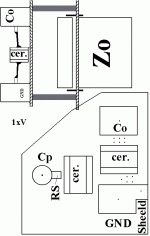What's the question 🙂
It looks quite old and tbh is badly drawn making it hard to follow at a glance. The VN10KM's are obsolete and were low power devices but interesting at the time they appeared.
The top part looks to be just a line driver of some sort. It states 5 volt into 50 ohm at the output. The lower parts seem to modulate the output of the top driver... very odd 🙂
It looks quite old and tbh is badly drawn making it hard to follow at a glance. The VN10KM's are obsolete and were low power devices but interesting at the time they appeared.
The top part looks to be just a line driver of some sort. It states 5 volt into 50 ohm at the output. The lower parts seem to modulate the output of the top driver... very odd 🙂
Schematic is absolutely unreadable 🙁
Can you make a better and bigger one so we be able to understand it better?
Can you make a better and bigger one so we be able to understand it better?
The same incomprehensible drawing style (and a similar lack of useful English text) is to be found in this thread: http://www.diyaudio.com/forums/solid-state/205736-disco-sound-system-otherwise.html.
Looks like the same circuit, too.
Looks like the same circuit, too.
Re:VMOSFET...
Tr. SK9155 is not old, but always precise and good.
Smooth static stabilization of the output voltage is not something bad, and the only unusual.
VMOSFET does not need to have high power because you are stable and must be specially transistors cooled. Expensive -price 40 000$.
Tr. SK9155 is not old, but always precise and good.
Smooth static stabilization of the output voltage is not something bad, and the only unusual.
VMOSFET does not need to have high power because you are stable and must be specially transistors cooled. Expensive -price 40 000$.
Expensive -price 40 000$.
So many capacitors and so many stages but no tone control??? 😱
Capacitor coupled stages all within a global loop.🙄 IMHO, direct coupling from stage to stage within a loop is best. With all the overlapping feedback loops and caps, this circuit might be easy to oscillate, you might get to listen to AM radio signals if the layout and filtering is not carefully done. All those electrolytics in the signal path make me cringe...
All those electrolytics in the signal path make me cringe...
 All those electrolytics in the signal path make me cringe...
All those electrolytics in the signal path make me cringe...
Re:VMOSFET...
My pure electronics and there is no oscillation excitation.
I use the stabilization of the output voltage and output capacitor complex filters, and connections to the nodes of current-voltage and electronic shield -screens. Frequency response of this amplifier is approximately 3 MHz.
My pure electronics and there is no oscillation excitation.
I use the stabilization of the output voltage and output capacitor complex filters, and connections to the nodes of current-voltage and electronic shield -screens. Frequency response of this amplifier is approximately 3 MHz.
Attachments
- Status
- Not open for further replies.
- Home
- Amplifiers
- Solid State
- VMOSFET transistors for amplifier class A




